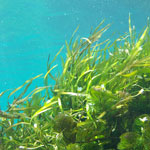World Seagrass Day Date in the current year: March 1, 2026
 World Seagrass Day is observed annually on March 1. It was established by the United Nations General Assembly to raise awareness of the importance of seagrasses for marine ecosystems and promote seagrass conservation efforts.
World Seagrass Day is observed annually on March 1. It was established by the United Nations General Assembly to raise awareness of the importance of seagrasses for marine ecosystems and promote seagrass conservation efforts.Seagrasses are the only flowering plants growing in marine environments. There are about 60 seagrass species that evolved from terrestrial plants which recolonized the ocean tens of millions of years ago. Although seagrasses are sometimes confused with seaweed (macroalgae), the two are not the same. The key difference between seagrasses and seaweed is that seagrasses are vascular plants that have have true stems, leaves and roots, whereas seaweed do not have a wide variety of specialized tissues. In addition, seagrasses produce flowers and seeds, while seaweed reproduce by producing spores.
Seagrasses are important for marine ecosystems and sustainable development for a number of reasons. First and foremost, they have been dubbed “the lungs of the sea” because they produce large amounts of oxygen through photosynthesis. Moreover, seagrasses have excellent carbon capture capabilities; they cover only 0.2% of the seabed but absorb 10% of carbon in the ocean. Both processes (oxygen production and carbon capture) help to keep marine ecosystems balanced and healthy.
Seagrasses also contribute to food security because they help support a great diversity and abundance of fish in both artisanal and commercial fisheries. Seagrass conservation is especially crucial for small-scale fisheries in developing countries, where people are heavily dependent on natural resources. Finally, seagrass meadows have been historically an important resource for coastal communities; they provide a range of socioeconomic, cultural, educational, and recreational opportunities and benefits.
Seagrasses have been declining globally over the past century, and the rate of decline has accelerated significantly since the 1990s. According to a recent census, 7% of seagrasses is being lost per year; the number probably doesn’t tell you anything, so let us paraphrase: an area equivalent to a football field of seagrass is lost every half an hour. More than one fifth of seagrass species are classified as Near Threatened, Vulnerable or Endangered on the IUCN List of Threatened Species.
The UN General Assembly designated March 1 as World Seagrass Day on May 23, 2022 by adopting a resolution sponsored by Sri Lanka. The main goals of the observance are to raise awareness of the adverse impacts of climate change and human activities on marine biodiversity, highlight the importance of seagrasses for climate change mitigation and adaptation, food security and sustainable development, educate about the threats that seagrasses face, and promote their conservation.
On the occasion of World Seagrass Day, conservation organizations, academic institutions, and other relevant stakeholders organize events to raise awareness of the importance of seagrass conservation and enhance international cooperation in the conservation of seagrasses and marine ecosystems in general.
- Category
- UN Observances
- Tags
- World Seagrass Day, UN observances, UN international days, environmental observances, seagrass conservation